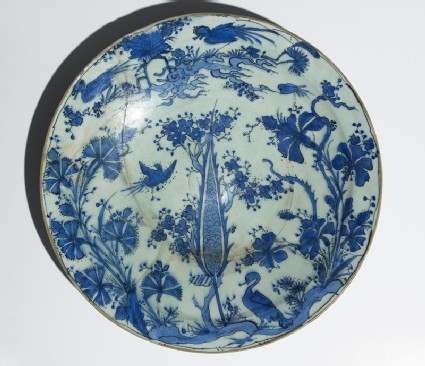Highlights: 1 object
- Reference URL
Actions
Dish with birds in a landscape
-
Details
- Associated place
- Date
-
17th century - early 18th century
Safavid Period (1501 - 1722)
- Material and technique
- fritware, with underglaze painting in blue
- Dimensions
-
8.5 cm (height)
47.5 cm (diameter)
- Material index
- Technique index
- Object type index
- No. of items
- 1
- Credit line
- Presented by Ralph Pinder-Wilson, 1986.
- Accession no.
- EA1986.50
-
Further reading
Allan, James W., Islamic Ceramics, Ashmolean-Christie's Handbooks (Oxford: Ashmolean Museum, 1991), no. 36 on p. 58, illus. p. 59
Glossary (2)
fritware, underglaze painting
-
fritware
Ceramic material composed of ground quartz and small quantities of clay and finely ground frit (frit is obtained by pouring molten glass into water).
-
underglaze painting
Painting applied to ceramic material before a transparent, or monochrome or coloured glaze for Islamic objects, is applied. The technique was initially developed in China.
Location
-
- currently in research collection
Objects are sometimes moved to a different location. Our object location data is usually updated on a monthly basis. Contact the Jameel Study Centre if you are planning to visit the museum to see a particular object on display, or would like to arrange an appointment to see an object in our reserve collections.
Publications online
-

Islamic Ceramics
This late example of Safavid blue and white shows vividly the way different styles and traditions were synthesised by the craftsmen-potters of the day. The stream with the goose standing beside it and the flowering prunus tree come straight from Chinese blue and white porcelain designs, as does the upper landscape with birds, cloud scrolls and a single lotus blossom. So too the brownish rim, which is commonly found on seventeenth century Chinese porcelain. The central cypress and the irises on the right hand side of the dish are taken from the lustre tradition (nos. 34-35 [EAX.3080 & EAX.1207]), and derive ultimately from book illumination. The carnations, on the left, are rare items on Persian blue and white. However they do appear on contemporary Kirman polychrome wares, in which they are used alongside a red – unique in Persian ceramics of the period. They may well have been introduced, therefore, by a potter who was acquainted with Iznik ceramics, on which, combined with a strong sealing-wax red, they are a standard floral element from the second quarter of the sixteenth century onwards (no. 47 [WA1888.CDEF.C324]).
© 2013 University of Oxford - Ashmolean Museum








